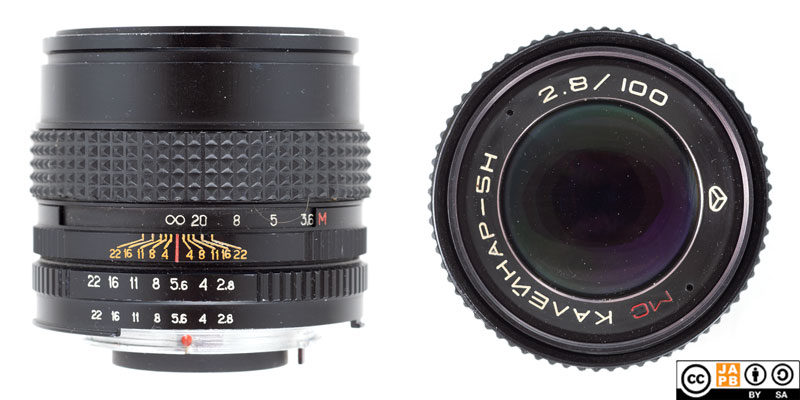Pekka Buttler, 06/2025

Specifications
The table below summarizes the lens’ key specifications (measurements based on pictured lens):
| Brand: | Kaleinar/Калейнар | Lens name | 5H 2.8/1000 (MC) |
| Focal length(s) 1 | 100 mm | Angle-of-view 2 | 24,5 ° (on ‘full frame’) |
| Maximum Aperture | f/2.8 | In Production | 1984–19913 |
| Lens mounts | Nikon F | Other lens mount | none 4 |
| Length 5 | 53,6 mm | Diameter 6 | 63,8 mm |
| Filter ring diameter | 52 mm | Weight | 290 grams |
| Lens element count | 5 | Lens group count | 4 |
| Aperture blades | 6 | Focus throw | 300 ° |
| Minimum focusing distance (measured) | 80,5 cm | Maximum magnification (measured) | 1:6,2 |
| Has manual aperture ring | YES | Has Manual focus ring | YES |
| Aperture mechanism type | automatic | Aperture click stops | 2.8•4•5.6•8•11-16-22 |
Further notes:
• The Kaleinar/Калейнар-5 is a 1980s Soviet short tele/portrait lens.
• The Kaleinar/Калейнар-5 was designed specifically to act as a moderate tele lens on the Kiev 17–20 series cameras that used the Nikon F mount (read more on that here).
• While not intended to be used on Nikon-made Nikon F mount bodies, Soviet lenses for the Kiev 17–20 system are (in a technical sense) Ai-compatible: they lack the rabbit ears and have the AI metering prong (so they are Ai-compliant, but have none of the systems Nikon added when going from the Ai to the Ai-s variant of the Nikon F mount.
• In contrast to previous Soviet implementations of short tele designs (like the Helios-40 or Jupiter-9), this design aimed to be significantly more frugal in its use of glass.
• The Kaleinar-name does not refer to a brand, design bureau or indeed a factory. Instead, the name Kaleinar indicates that it is a member of a late-soviet-era family of short tele lenses. See more in the JAPB articles on Soviet lenses and the Soviet lens ‘business’
• Manufacture of the Kaleinar/Калейнар-5H began in 1981 and continued past the demise of the Soviet Union.
The pictured sample also carries a (rather flimsy) extendable lens hood.
Versions
Notwithstanding some prototype copies manufactured for theLeica M mount, all 50+ samples of the Kaleinar-5 I have seen fall into three designs: early, normal and late.
Early versions seem to have only been manufactured at the absolute beginning of the production run and can be characterised by that the ‘MC’ acronym on the lens’ name ring is in white (on all subsequent samples, the MC is in red). They are otherwise very similar to the other versions.
Normal versions were manufactured between 1982 and 1988 and they sported a metal focus ring (patterned with elongated pyramids/cut ridges) and carried the serial number on the lens’ name ring. However some 1988 samples are already of the later type and there are also samples that combine traits of the normal and late versions.
Late versions sport a relatively narrow (12 mm) rubber focus ring and do not carry the lens’ serial number on the name ring. These lenses are likely also significantly lighter than the earlier versions. The pictured lens is of this type. Last serial number spotted in the wild indicates manufacture ended after 1996.
Seemingly, this lens was never intended for the export market, as only one lens has ever been seen sporting anything but a Cyrillic name (and that lens carried the name CALEJNAR, so it might have been a prototype).
Adapting
Besides adapting, this lens can be used natively on all current high-end Nikon dSLRs and several earlier medium-to-high-end older Nikon dSLRs 7. Likewise, if jury-gigged with rabbit ears, it can be natively used on all Nikon F-mount film cameras ever produced (without the rabbit ears, it is limited to post–1977 bodies).
Thanks to being a fully manual lens (manual aperture, manual focus), the lens can be adapted to all mirrorless cameras using a suitable dumb adapter (and such adapters are easy to find). Moreover, a wide range of special adapters (helicoid adapters, tilt/shift adapters, speed boosters) for using Nikon F lenses on most mirrorless systems are available.
Using Nikon F lenses on non-Nikon SLRs and dSLRs is likewise a distinct possibility. Thanks to the relatively generous flange focal distance of the Nikon F mount (46,5 mm), adapter rings for all dSLR mounts are available as well as for a goodly portion of film-era SLR mounts. Such rings may not allow for auto aperture, but even then the lenses can be used in stop-down metering mode.
Footnotes
- Focal length is (unless stated otherwise) given in absolute terms, and not in Full-frame equivalent. For an understanding of whether the lens is wide/tele, see ‘Angle-of-view’. ↩︎
- Picture angle is given in degrees (based on manufacturers’ specs) and concerns the diagonal picture angle. Rule of thumb:
> 90 ° ==> Ultra-wide-angle
70–90 ° ==> Wide-angle
50–70 ° ==> Moderate wide-angle
40–50 ° ==> ‘Standard’ or ‘normal’ lens
20–40 ° ==> Short tele lens
10-20 ° ==> Tele lens
5-10 ° ==> Long tele lens
< 5 ° ==> Ultra-tele lens ↩︎ - Serial production is reputed to have begun in 1984. Based on serial numbers of documented lenses, manufacture dropped sharply after 1990 and latest samples have serial numbers indicating manufacture in 1991. ↩︎
- According to some documentation, these lenses usually left the Kiev factory with a Nikon F mount and an adapter from Nikon F to M42. ↩︎
- Length is given from the mount flange to the front of lens at infinity. ↩︎
- Diameter excludes protrusions such as rabbit ears or stop-down levers. ↩︎
- As of this writing, the following Nikon dSLRs fully support Aperture priority and manual metered modes on Nikkor Ai lenses: D2, D3, D4, D5, D6, D200, D300, D300s, D500, D600, D610, D700, D750, D780, D800, D800E, D810, D850, D7000, D7100, D7200 ↩︎